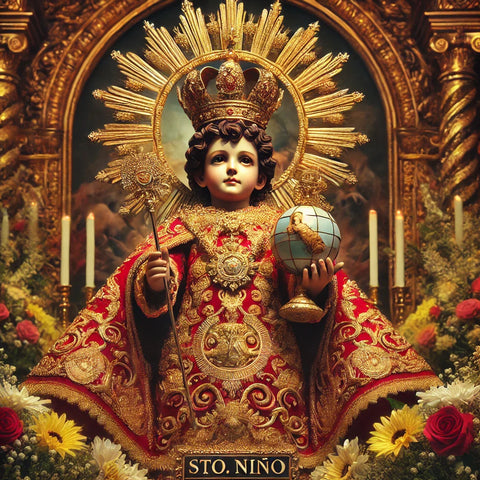The devotion to Sto. Niño is a story of love, resilience, and unwavering faith that has stood the test of time. Its roots go back over five centuries, beginning with an extraordinary gift that would forever change the spiritual landscape of the Philippines.
A Gift of Faith
In 1521, Portuguese explorer Ferdinand Magellan and his fleet landed on the shores of Cebu. As a gesture of goodwill and a symbol of the new Christian faith they hoped to spread, Magellan presented a statue of the Holy Child Jesus to Queen Juana of Cebu. The queen was so moved by the gift that she and her husband, King Humabon, embraced Christianity and were baptized, along with hundreds of their subjects.
What makes this story even more remarkable is what happened after Magellan’s death. The Sto. Niño statue disappeared for decades, only to be rediscovered intact in 1565 during Miguel Lopez de Legazpi’s expedition. The miraculous preservation of the image, amidst the ruins of a fire, cemented its place in Filipino hearts as a divine symbol of God’s protection and love.
A Devotion Passed Through Generations
Today, the Sto. Niño is more than a relic; it’s a symbol of Filipino identity and faith. The image, enshrined in the Basilica Minore del Santo Niño in Cebu, is the focal point of the annual Sinulog Festival. This vibrant celebration draws millions of devotees who dance, pray, and express their gratitude for blessings received.
But the devotion to Sto. Niño isn’t limited to grand festivals. In homes across the Philippines, statues of the Holy Child grace altars, often adorned with intricate clothing and offerings. Families pray to Him for guidance, protection, and miracles, believing in His enduring presence in their lives.
Miracles of Sto. Nino
The Sto. Niño is not just a symbol of faith; it is a source of many documented miracles.
In 1906, a devastating fire swept through a small village in Cebu. Houses were reduced to ashes, and panic engulfed the community. As the flames threatened to consume the local chapel, a group of villagers brought out the statue of Sto. Niño and prayed fervently. Miraculously, the fire changed direction, sparing the chapel and the surrounding homes. The villagers saw this as a divine intervention, solidifying their devotion to the Holy Child.
In 1565, a severe smallpox epidemic afflicted the people of Cebu. The community turned to the Santo Niño for divine intervention, conducting a novena and processing the image through the village. Following these devotions, the epidemic ceased, an event attributed to the miraculous intercession of the Holy Child.
Historical accounts describe how the early Cebuanos would invoke the Santo Niño during droughts. They would take the image in procession to the seashore, immerse it in water, and pray for rain. Their faith was often rewarded with the much-needed rainfall, a practice that underscored the deep-seated belief in the Santo Niño's providence.
Why Sto. Niño Matters Today
In a world filled with uncertainties, the Sto. Niño remains a beacon of hope and a reminder of God’s love. The image of the Holy Child, with His innocent gaze and humble demeanor, inspires Filipinos to trust in God’s plan and approach life with childlike faith.
The devotion to Sto. Niño is more than tradition; it’s a way of life that brings people together, strengthens communities, and fosters a spirit of gratitude and resilience. For many, the Sto. Niño is not just a figure in a church but a constant companion, offering comfort and assurance in times of need.
As we honor the Sto. Niño, let us remember the profound impact of this devotion on Filipino culture and spirituality. May His story inspire us to live with faith, hope, and love, trusting that miracles can happen when we place our hearts in God’s hands.

